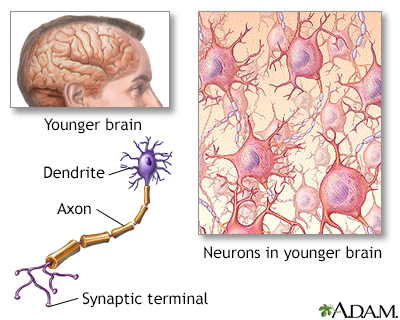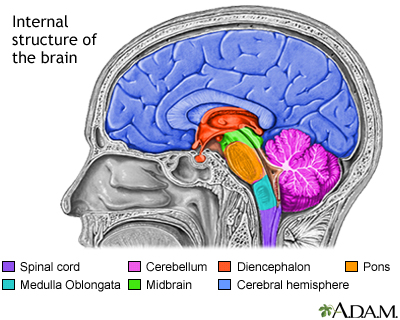Provisional tic disorder
Tic - transient tic disorder
Provisional (transient) tic disorder is a condition in which a person makes one or many brief, repeated, movements or noises (tics). These movements or noises are involuntary (not on purpose).
Images




Causes
Provisional tic disorder is common in children.
The cause of provisional tic disorder can be physical or mental (psychological). It may be a mild form of Tourette syndrome. Provisional means that the tic has been present for less than a year.
Symptoms
Your child may have facial tics or tics involving movement of the arms, legs, or other areas.
Tics may involve:
- Movements that occur again and again and do not have a rhythm
- An overwhelming urge to make the movement
- Brief and jerky movements that include blinking, clenching the fists, jerking the arms, kicking, raising the eyebrows, sticking out the tongue
The tics often look like nervous behavior. Tics appear to get worse with stress. They may be less frequent during sleep or not occur during sleep at all.
Sounds may also occur, such as:
- Clicking
- Grunting
- Hissing
- Moaning
- Sniffing
- Snorting
- Squealing
- Throat clearing
Exams and Tests
Your health care provider will consider physical causes of provisional tic disorder before making a diagnosis.
In order to be diagnosed with provisional tic disorder, symptoms must be present less than one year and not be due to other conditions including use of substances.
Other disorders such as anxiety, attention deficit hyperactivity disorder attention deficit hyperactivity disorder (ADHD), uncontrollable movement (myoclonus), obsessive-compulsive disorder (OCD), and epilepsy may need to be ruled out.
Treatment
Providers recommend that family members do not call attention to the tics at first. This is because unwanted attention may make the tics worse. If the tics are severe enough to cause problems at school or work, behavioral techniques and medicines may help.
Outlook (Prognosis)
Simple childhood tics usually disappear over a period of months. If symptoms persist for more than three months, they are more likely to become chronic.
Possible Complications
There are usually no complications. A chronic motor tic disorder can develop.
When to Contact a Medical Professional
Talk to your child's provider if you are concerned about a provisional tic disorder, especially if it continues or disrupts your child's life. If you are not sure whether the movements are a tic or a seizure, contact your provider right away.
Related Information
Facial ticsChronic motor or vocal tic disorder
References
Kim JW, Walter HJ, DeMaso DR. Motor disorders and habits. In: Kliegman RM, St. Geme JW, Blum NJ, et al, eds. Nelson Textbook of Pediatrics. 22nd ed. Philadelphia, PA: Elsevier; 2025:chap 37.
Singer HS, Mink JW, Gilbert DL, Jankovic J. Tics and tourette syndrome. In: Singer HS, Mink JW, Gilbert DL, Jankovic J, eds. Movement Disorders in Childhood. 3rd ed. Philadelphia, PA: Elsevier; 2022:chap 7.
Tochen L, Singer HS. Tics and Tourette syndrome. In: Swaiman K, Ashwal S, Ferriero DM, et al, eds. Swaiman's Pediatric Neurology: Principles and Practice. 6th ed. Philadelphia, PA: Elsevier; 2017:chap 98.
BACK TO TOPReview Date: 3/31/2024
Reviewed By: Joseph V. Campellone, MD, Department of Neurology, Cooper Medical School at Rowan University, Camden, NJ. Review provided by VeriMed Healthcare Network. Also reviewed by David C. Dugdale, MD, Medical Director, Brenda Conaway, Editorial Director, and the A.D.A.M. Editorial team.

Health Content Provider
06/01/2025
|
A.D.A.M., Inc. is accredited by URAC, for Health Content Provider (www.urac.org). URAC's accreditation program is an independent audit to verify that A.D.A.M. follows rigorous standards of quality and accountability. A.D.A.M. is among the first to achieve this important distinction for online health information and services. Learn more about A.D.A.M.'s editorial policy, editorial process and privacy policy. A.D.A.M. is also a founding member of Hi-Ethics. This site complied with the HONcode standard for trustworthy health information from 1995 to 2022, after which HON (Health On the Net, a not-for-profit organization that promoted transparent and reliable health information online) was discontinued. |
The information provided herein should not be used during any medical emergency or for the diagnosis or treatment of any medical condition. A licensed medical professional should be consulted for diagnosis and treatment of any and all medical conditions. Links to other sites are provided for information only -- they do not constitute endorsements of those other sites. © 1997- 2025 A.D.A.M., a business unit of Ebix, Inc. Any duplication or distribution of the information contained herein is strictly prohibited.
